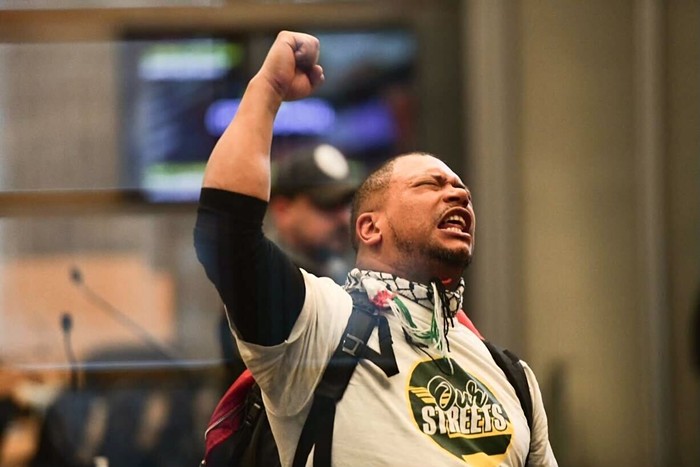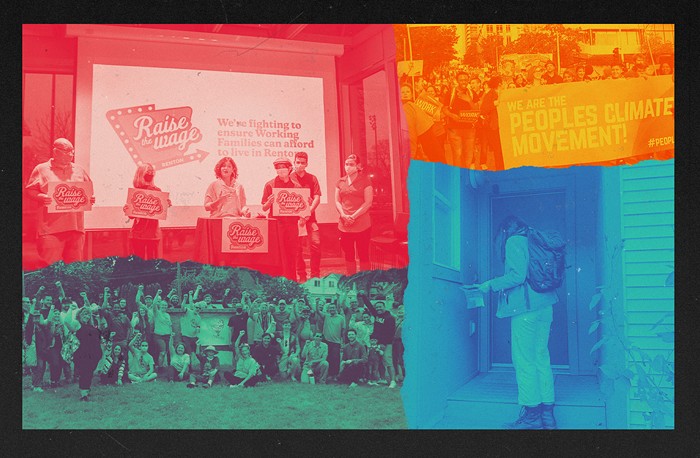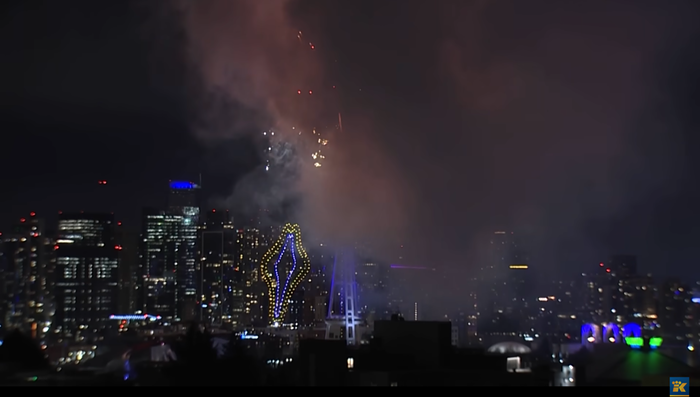
Sometimes you don't know you're in a fight until the other person suddenly hauls off and socks you. Then you reel back, grab your jaw, and think, did that really just happen? Whoa! Did you really just do that? We were talking! Dang!
That's what happened Monday downtown when environmental activists and Native American water protectors squared off against Seattle Police at a "Shutdown Chase" direct action rally in front of the Russell Investment Center. No one got physically socked, but many Native people were stunned almost as badly when Seattle Police callously destroyed four sacred Native American structures.
The event was intended to speak out against JP Morgan Chase Bank's funding of a pipeline in Canada bringing tar sands oil to tankers in the Salish Sea, an area from Puget Sound to British Columbia. Four members of the environmental action group 350 Seattle perched themselves atop four tipi-like structures called "tarpees" in the middle of Second Avenue, blocking traffic for about four hours. It was beautiful.
I didn't see the tarpees being set up. I was part of a diversionary team sent to draw police away from the location of the main action downtown. I and eight others met at Westlake Park at 8:30. Facebook event postings said to meet there at 9 and the cops were ready. About five of them stood in a group by Westlake Mall, chatting and eyeing us occasionally. Great, we thought, they're taking the bait.
At 9 we began walking south on Fourth Avenue. Four cops on bikes followed a half block behind us. One rode up a little closer and said, "Nice day for a walk!" Smug bastard.
An observer from another team said she drove past us and saw not only the four cops on bikes, but four police SUVs following us. We thought, Yes! This is so cool!
We rallied briefly in front of the Chase bank branch on 12th and Madison and at a different branch a few blocks away. Then we returned back downtown, all the while with our retinue of cops following behind like toy ducks on a string.
I turned the corner from University Street to Second Avenue and looked up to see a vision: four Native American tipis sitting smack dab in the center of one of the busiest streets in downtown Seattle.
I've seen tipis before and even attended ceremonies in one, but nothing prepared me to see them in the middle of the city. They were big. Like you could ride a horse inside one and not bump your head big.
This is what we were distracting the cops away from. And it worked! Hardly any cops were there, allowing the main event teams to erect the tarpees.
One of the direct action's organizers, Paul Cheoketen Wagner, a member of the Saanich tribe and cofounder of Protectors of the Salish Sea, told me how it went down.
"A team of traffic blockers dressed as construction workers stopped traffic on Second Avenue and set out cones across Union Street. Then a truck carrying the tarpees zoomed into position and teams pulled the tarpees out and one by one opened them. They're like giant umbrellas. Another team put together a small-scale replica of a Native American longhouse and used it as a blockade across Union. The whole thing was done in under eight minutes."
At the same time the tarpees were set up, a group of mostly women wearing red entered the Chase Bank lobby on the first floor of the Russell Investment Center and formed a circle. They were members of the group Missing and Murdered Indigenous Women and Girls, #MMIWG. Carolyn DeFord, a Puyallup tribal member, was there in remembrance of her mother, Leona, who disappeared in 1999 and her cousin Lenor who was murdered in 2002.
"At first the people in the bank didn't know what was going on," DeFord told me later. "We kind of took them by surprise."
In the lobby, Rachel Heaton, a Muckleshoot tribal member and cofounder of Mazaska Talks, pointed out the connection between pipeline construction and "man camps" that contribute to the violence suffered by indigenous women.
"We are not fighting against people," she said. "We are fighting against a system. By keeping your money in this bank you contribute to a system that inflicts violence on women, men and children."
Matt Remle, a Hunkpapa Sioux, long time Seattle Native activist, and cofounder of Mazaska Talks, a Native divestment action group, told me later the tipi has great spiritual significance to many Native tribes.
"Tipi is a Lakota word meaning 'where they live,'" he said. "The shape is sort of like an hourglass because the poles inside come together at one point at the top of the tipi and then extend back out above it. So it's like the forces of the sky and the Earth come together and mix inside the tipi. It protects and nurtures us, so we regard the tipi as our mother."
"All we wanted was to talk face-to-face with Phyllis Campbell, the chairman of Pacific Northwest JP Morgan Chase, so we could discuss the bank's funding of tar sands pipelines," Paul Cheoketen Wagner told me. "After that we would have taken down the tarpees. But she wouldn't talk with us and the cops wouldn't negotiate with us."
Police used a fire truck ladder to extricate the four 350 Seattle activists from their platforms on top of the tarpees. The four activists, Danny Lange, Aaron Brouillette, Antonio Zamora and Sean Fujimori were loaded into the back of a police van. The tarpees were then collapsed, sawed in two, and loaded on a SDOT truck.
Wagner, who created the tarpees based on traditional tipi designs, was visibly shaken when he realized what was happening. He made similar tarpees for water protectors at Standing Rock. The tarpees erected on Monday were used at a previous direct action event and people prayed over them and lived in them.
"Those are sacred!" Wagner called to the cops who laughed as they destroyed the four mother figures right out in plain sight.
On February 7, 1865, the Seattle Board of Trustees banned all Indian people from living in the city by signing into law Seattle Ordinance No. 5.
"...no Indian or Indians shall be permitted to reside, or locate their residences on any street, highway, lane, or alley or any vacant lot in the town of Seattle..." the ordinance stated.
An estimated 94 Duwamish longhouses were burned to the ground by white settlers between 1855 and 1904. When Seattle Police demolished and desecrated the four sacred tarpees on Monday, they were following an old Seattle tradition. The unnecessary, public destruction was seen by many as a message from the cops that nothing has changed. The brutal racism of city law enforcement from the 1800s is still here and on Monday it sucker punched us all.
On May 9, Seattle police spokesperson Tracy K. Clayton provided this email response to my request for a comment:
We respect the cultural significance of the structures used in the demonstration, and we are working to return them today. Following the May 7 demonstration at 2nd Avenue and University, the structures in the public right of way were disassembled for transport. While small portions of these structures must be processed and kept as evidence in cooperation with the City Attorney’s Office, we are working to return the remaining portions as quickly as possible.


















